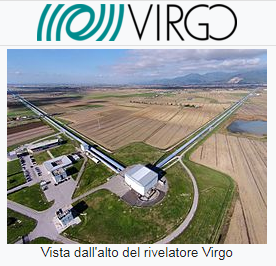
dal 1996 in continua innovazione tecnologica!
Sfrutta tecnologie avanzate per avere un sito web ottimizzato al 100%

EGO, the European Gravitational Observatory, located in the countryside near Pisa in the Municipality of Cascina, was created 20 years ago (December 11, 2000) by the French Center National de la Recherche Scientifique (CNRS), and by the Italian National Institute of Nuclear Physics (INFN). NIKHEF Laboratory (Netherlands) joined in 2007 with observer status and in early 2021 as a member.
Virgo is a large interferometer built by an international collaboration to detect gravitational waves from the universe; gravitational waves are an effect predicted by Einstein's theory of general relativity.
The Virgo gravitational interferometer
The Virgo collaboration consists of over 280 physicists and engineers from 20 different European research groups: six groups from the Center National de la Recherche Scientifique (CNRS) in France; eight at the National Institute of Nuclear Physics (INFN) in Italy; two at the Nikhef in Holland; MTA Wigner RCP in Hungary; the POLGRAW group in Poland; the University of Valencia in Spain; and the European Gravitational Observatory, EGO, the laboratory hosting the Virgo detector near Pisa in Italy, funded by CNRS, INFN and Nikhef. EGO provides support for the maintenance of the site and its infrastructure; deals with the management of the computational center for data analysis. This body promotes and funds some of the research and development activities of the experimental and theoretical field of gravitational wave research in Europe.
There are other gravitational wave detectors similar to Virgo in the world: in particular the two LIGO detectors in Hanford and Livingston in the United States, also large interferometers with 4 km long arms, in whose data in 2015 it was recorded for the first time the passage of a gravitational wave (GW150914), jointly discovered by the LIGO and Virgo collaborations. The discovery earned him the Nobel Prize in Physics awarded in 2017.
The Virgo interferometer takes its name from the Virgo Cluster which consists of about 1 500 galaxies in the constellation Virgo and is about 50 million light-years away from Earth.
